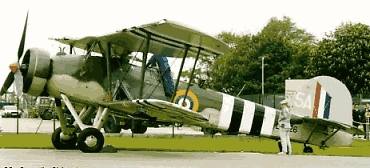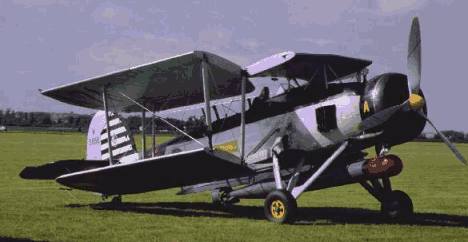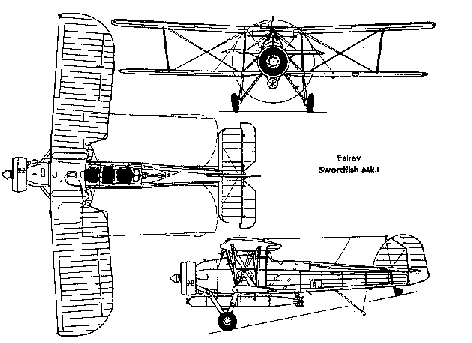|
Fairey Swordfish

One of the most important aircraft of the war was also one of the most outdated. The Fairey Swordfish's accomplishments are legendary, and it is surprising to most all people the things that a biplane could do.
 |
The Swordfish was mainly a naval aircraft, serving from such carriers as the Ark Royal. It was Swordfish that crippled the German battleship Bismarck, leading to its destruction at the hands of the British home fleet. It was Swordfish which, at the Italian port of Taranto, made what was thought to be a minor raid on the Italian fleet, but turned out to be a major crippling of Italian naval power, tipping the balance of power towards (Later on; Grand Admiral) Cunningham's Mediterranean fleet. |
| The Swordfish began as Fairey Aircraft company's private-venture T.S.R.1 biplane. The prototype was destroyed in an accident during September 1933. However, its performance warranted further development. When the Air Ministry issued Specification S.15/33, calling for a carrier-based torpedo bomber/reconnaissance craft, the newly deemed Swordfish was submitted as T.S.R.2, and was accepted. |
| The first true Swordfish, (Mk.1, designated K4190) became operational in July 1936, first used by no. 825 Squadron as a replacement for the Fairey Seal. By 1938, the FAA's torpedo bomber squadrons were equipped solely with Swordfish. When war began, there were 13 operational squadrons, 12 of which were at sea aboard Ark Royal, Courageous, Eagle, Furious and Glorious. On the 13th of April, 1940, a catapult-launched Swordfish from HMS Warspite sank U-64, the first U-boat sinking of the war. |
 |
The Swordfish went on to bigger and grander things, and was still in use long after D-Day, used principally for attacks against enemy shipping. Many were equipped with rockets. The last operational Swordfish squadron was disbanded on 21 May, 1945.
Charles Bain

Technical Data
Origin: Fairey Aircraft Company
Type: Two/three seat torpedo bomber or reconnaissance biplane.
Engine: One 559-kW (750hp) Bristol Pegasus XXX 9-cylinder radial piston engine
Weights: Empty 2132kg (4,700lb) maximum take-off, 3406kg (7,510lb)
Performance: Maximum speed 222 km/h (138 mph); service ceiling 3260 m (10,700ft)
Range 1658 km (1,030 miles)
Dimensions: Span 13.87m (45ft 6 in); Length 10.87 m (35ft 8in);
Height 3.76m (12ft 4in)
Armament: One forward-firing synchronised 7.7mm (0.303 in) Vickers machine gun in fuselage and another Lewis or Vickers K gun on Fairey High-Speed mounting in rear cockpit. A 730kg (1,610lb) Torpedo, or depth charges or mines up to 680kg (1,500lb), or up to eight rocket projectiles on underwing racks.
|


